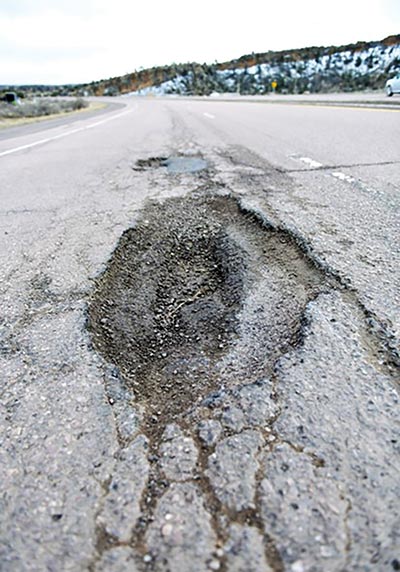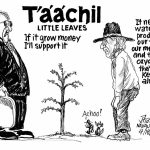
Guest Column | Potholes unforgiving
By Bazhnibah

Ruth (Bazhnibah) Kawano
Editor’s note: Bazhnibah is Ruth Kawano, the wife of Kenji Kawano. She is a retired registered nurse, a former U.S. Public Health Service captain, a former U.S. Air Force captain, and a former flight nurse. She is currently a writer-photographer.
We have been inundated with potholes on the Navajo reservation since the pandemic, but “this winter it is the worst,” so say the people. From tires busting to rims being damaged to accidents, these potholes are not forgiving. Then there is the dangerous swerving to avoid the potholes. And if your passengers aren’t wearing a seatbelt, they can be bumped around, hitting parts of the vehicle, and injuring themselves. If you are unfamiliar with the area and driving at night, you are in for the ride of your life.
According to the internet, a pothole is a shallow to deep depression of asphalt pavement where vehicles remove pieces of the pavement as people drive over them. “It is usually the result of water in the underlying soil structure and traffic passing over the affected area.”

Special to the Times | Bazhnibah
A pothole is in the asphalt on a rural roadway.
Water from rain or snow weakens the soil underneath the road. The traffic fatigues and breaks the poorly supported asphalt surface, and continued traffic ejects the road and soil materials to create a hole in the pavement.
OK, there we have it. We know how they form and look since asphalt roads began in the early 1900s when people started driving vehicles in the U.S., and we began to see potholes. But decades ago, they were not as bad as they are now. We know, too, that if these potholes become large, damage to tires, wheels, and vehicle suspensions is liable to happen.
On a recent Facebook conversation about potholes, one unlucky fellow had his tire and rim damaged so severely he couldn’t drive it without laboring on it for many hours. One spent “over $1,000” for the damage to his tires and rims. Another got “busted tires.” He called the state Department of Transportation for help and got help from a local police officer to assess his damage. Others witnessed accidents; one was a truck blowing out tires from a pothole and hitting another vehicle with a baby inside.
All these incidents and accidents have also caused emotional trauma; the costs and time associated with tires, injuries, and loss of vehicles, and lives, can be devastating. It’s been mainly band-aiding roads the past few years, but we need new stable, well-maintained roads. Some ask where the tax money goes, where people get help, and what the leaders can do to help. People cannot just stay home to avoid potholes; we no longer have horses and carriages.
So, what is a Nation to do? There is evidence that insufficient pavement thickness, drainage, and beginning cracks left unmaintained are causes of potholes. Some say that semi-trucks also add to the reason because of their weight on the pavement.
We want to think that the Navajo Nation has done road assessments and surveys and looked at drainage issues. Maybe more patching until we get better repairs done is needed. We also know that it costs a lot of money to repave with thick pavement and will cause traffic delays and is labor intensive.
We do our share of paying taxes at the gas pumps and the grocery stores, and many tax dollars go to Gallup, Flagstaff, Holbrook, Farmington, and other border towns for Navajo shopping. Where does that money go? It’s time to probe these endpoints of where tax dollars go. Maybe we can also all donate a few bucks to the Nation to get the roads redone.








 Highway 264,
Highway 264, I-40, WB @ Winslow
I-40, WB @ Winslow